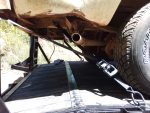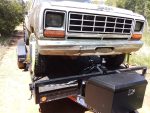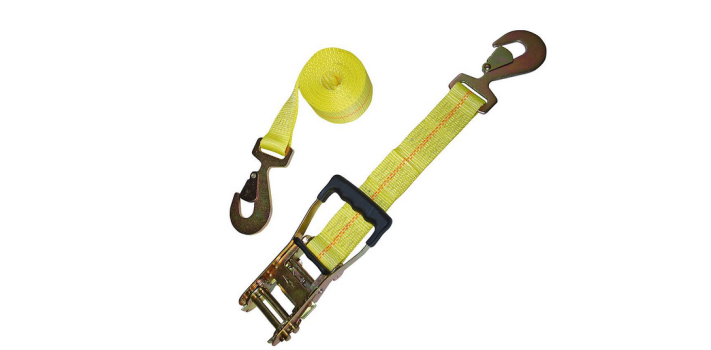Our preparedness lifestyle often requires us to haul things. Bulk supplies, fuel, farm equipment, and heavy vehicles are just a few examples. I have a background in construction, industry, and transportation. I have been trained in load securement techniques that conform to OSHA and DOT standards, and I apply them in my personal life. Load securement is not only for the workplace. Why? I want to avoid the consequences of doing a job improperly.
In my previous career in the poultry industry, employees had to follow a lot of rules. We had a saying: “Rules exist because somebody did something stupid and got hurt.” I know that for people experienced in industry, having the safety guy looking over your shoulder and critiquing your work is not a fun experience. You want to get the job done and get on with your day. Sometimes a shortcut works, sometimes it gets you hurt. When society is running well and there is an ambulance and a hospital close by, perhaps taking a risk now and then might not cost you much. But what happens when those services are unavailable? Planning for crisis events in the future should involve planning to be more careful than you are now.
Let me start with the consequences of improper load securement. The lowest level is missing your stuff. My father lost a roll of garden wire off his truck, one afternoon. A simple thing. But before he could turn around, somebody who had seen it drop had stopped and stolen it. That cost about $50. There have been multiple times as a commercial driver where I have nearly hit lost cargo on the highway. Often, I see refrigerators! That kind of hazard is really unsettling, not to mention wasteful. Even used appliances can cost several hundred dollars. Sure, there may be more at the store right now, but maybe not in the future. Or maybe there won’t be the money to pay for it. Load securement simply prevents loss.
The next level of consequence is injury to yourself and/or other people around you. I have seen that on construction sites. One coworker who was guiding a stack of pipes being lifted by a backhoe was slapped by a chain that came loose. The load remained intact because of other chains, but my coworker’s hand was injured and he also received two broken ribs. He got lucky, as he could have been crippled or killed. He only had to work one-handed on light duties for a few weeks while he healed and received physical therapy. What happens if you are injured? Can your family do without your income? Can your family do without your labor in a crisis situation? Can your family do without you? Can your reputation and finances handle a lawsuit from somebody that you carelessly injured? What about your conscience?
Load securement seems complicated, but there are a few general principles to remember. My primary saying is, “When you think you have enough, add more!” You will want to have:
- The right kind of straps or chains.
- Enough straps or chains.
- Straps or chains that are in good condition
- Enough separate points of contact, and in the right places.
- A properly balanced load.
For many farm jobs, an assortment of nylon straps and haul chains get things done. But do you know how much weight they hold? Each load securement device, whether it is a strap or a chain, has two ratings. Attachments such as hooks have them as well. The first rating is a service or working load rating. The second is a break-strength rating. For example, a set of nylon ratchet straps from Harbor Freight has a service rating of 1,000 lbs, but a break strength rating of 3,000 lbs. Never count on the break-strength rating! Always use the service rating as your guide, and make sure that the combined strength of the straps you use exceeds the weight of the object you are trying to haul. For example, I recently hauled an old Dodge pickup. The curb weight of that truck is 3,800 lbs. I tied the truck down with three straps rated at 1,000 lbs each, two straps service-rated at 2,500 lbs each, and two wheel straps service-rated at 2,500 lbs. Added up, that’s a combined service rating of 13,000 lbs – more than four times the weight of the truck. The combined breaking strength is higher. Always make sure you have more than enough, and if you are in doubt just add more!
Before use, inspect all your load securement devices. On chains, are the hooks in their original shape? Are the welds on links solid? Is the chain extremely rusty? Do you know the rating of your chain? If you cannot answer those basic questions, get a different one. If you are using chains, you are probably also using ratcheting load binders (also called “boomers.”) Inspect the teeth of the binder. Are they worn such that they might slip? Have the binder’s threads been oiled for ease of use?
On nylon straps, inspect the ratchet mechanism. Does it move freely? Are the teeth worn? Is corrosion present? On the strap itself, are the stitches in good condition? Are any coming loose? Are there any rips, tears, or piercings in the strap? If so, not only should you avoid using the strap, you should cut through the stitches with a knife and discard it. This prevents anybody else from taking chances and using it carelessly. Anticipating hard times, make sure that you purchase extra straps, ratchets, and chains. Purchase now, and store straps properly away from gnawing vermin. You do not want to be put in a position of using unsafe equipment because it is the only thing you have. Failing to prepare is just preparing to fail.
 Points of contact are important. On objects that roll, you need to have at least 4 separate points of contact. For example, if you are securing a vehicle on a trailer, each corner of the vehicle must be bound to the trailer by its own strap or chain. If you use the same chain to hold onto both rear corners of a vehicle, you only have one point of contact there instead of two. If that chain breaks, you lose the entire rear of the vehicle, rather than just one corner.
Points of contact are important. On objects that roll, you need to have at least 4 separate points of contact. For example, if you are securing a vehicle on a trailer, each corner of the vehicle must be bound to the trailer by its own strap or chain. If you use the same chain to hold onto both rear corners of a vehicle, you only have one point of contact there instead of two. If that chain breaks, you lose the entire rear of the vehicle, rather than just one corner.
The length and overall size of the object you are hauling is important. According to DOT regulations, all cargo no matter the size must have at least two straps holding it down. Longer cargo on flatbed trailers must have at least one strap for every 10 feet of length. Remember, that is a minimum requirement. More is better.
Back to the example of the Dodge pickup I was hauling – it is approximately 20 feet long. It is also a large, rolling object. Not only do my straps have to hold the weight, there must be points of contact at each corner, which also fulfills the minimum requirement of 2 straps for any cargo and at least one strap per 10 feet of cargo. That means a minimum of 4 straps, and preferably more.
 As you secure whatever you are hauling, try to make sure that your load is balanced. First, if you have a choice, put heavy things on the bottom. The less top-heavy your cargo is, the less it will shift and the less chance you have of a rollover accident. Second, make sure that weight is evenly distributed from side to side. Again, one side overloaded can cause a rollover. Uneven loading also stresses vehicle axles and suspension. Third, make sure your load is balanced front to back. This is especially important with a trailer. A trailer overloaded in the front will drag the rear of your vehicle lower, and possibly cause the tip of the trailer to hit the ground. A trailer overloaded in the rear risks detaching from the vehicle towing it, and can cause traction problems. While the size of your cargo and the size of your vehicle or trailer may limit your positioning options, the closer the weight is to being in the middle and/or over the axles, the easier and safer your trip will be.
As you secure whatever you are hauling, try to make sure that your load is balanced. First, if you have a choice, put heavy things on the bottom. The less top-heavy your cargo is, the less it will shift and the less chance you have of a rollover accident. Second, make sure that weight is evenly distributed from side to side. Again, one side overloaded can cause a rollover. Uneven loading also stresses vehicle axles and suspension. Third, make sure your load is balanced front to back. This is especially important with a trailer. A trailer overloaded in the front will drag the rear of your vehicle lower, and possibly cause the tip of the trailer to hit the ground. A trailer overloaded in the rear risks detaching from the vehicle towing it, and can cause traction problems. While the size of your cargo and the size of your vehicle or trailer may limit your positioning options, the closer the weight is to being in the middle and/or over the axles, the easier and safer your trip will be.
Think you are loaded up and ready to roll? Well, you might be. But as soon as you get going, you need to stop again. If you have traveled over rough terrain, then your load has probably shifted. If you have accelerated or braked suddenly, your load has probably shifted. Is it raining? Your load has probably shifted. Temperature changed dramatically? Your load has probably shifted! Let it sit outside overnight? Well, you get the picture. Never count on things staying the same. DOT regulations tell commercial flatbed drivers to stop and resecure the load in the first 25 miles, and every 150 miles or 3 driving hours after that. In my auto-hauling adventures, I prefer to stop before getting on any main road, even if I have only traveled a couple of miles. It takes only a minute to get out and check each strap.
 Notice the tie-down on the wheel in the image? That slippage happened after two miles of driving on a rough and rocky dirt road. Wheel straps are especially prone to shifting, and I prefer not to rely on them as a primary attachment point. Instead, I use holes in the vehicle’s frame on each corner, front and rear.
Notice the tie-down on the wheel in the image? That slippage happened after two miles of driving on a rough and rocky dirt road. Wheel straps are especially prone to shifting, and I prefer not to rely on them as a primary attachment point. Instead, I use holes in the vehicle’s frame on each corner, front and rear.
If you are hauling liquid cargo such as 55 gallon barrels or 300-gallon totes, you need to be especially careful. Liquid cargo shifts as you drive even if you are gentle, and that stress can tug on and loosen your securement devices. If you plan on hauling round objects such as barrels, make sure that you invest in harnesses meant for the purpose. When I haul 55-gallon drums of liquid, each barrel has its own harness, and two points of contact to the trailer. Finally, all the barrels are strapped to each other in a group. Remember that if you haul bulk quantities of liquid in larger containers, you need to make sure that you are allowed to do so. Depending on the quantity you are hauling, the size of the containers, and the nature of the cargo, you might be committing a violation if you do not have the proper training.
These websites, as well as a YouTube training video, describe basic load securement terms and practices. While they are intended for commercial drivers, the principles are the same for hauling farm equipment and personal items.
- https://www.macallisterrentals.com/equipment-transportation-load-securement-guide/
- https://www.fr8star.com/blog/flatbed-load-securement/
- https://www.fmcsa.dot.gov/regulations/cargo-securement/cargo-securement-rules
- https://www.youtube.com/watch?v=ApXQCm2r9nA
In short, you owe it to yourself, your family, and others around you to familiarize yourself with load securement best practices, and then implement them consistently. Not only will you experience better-hauling results, you will have the peace of mind that only diligence can bring.










